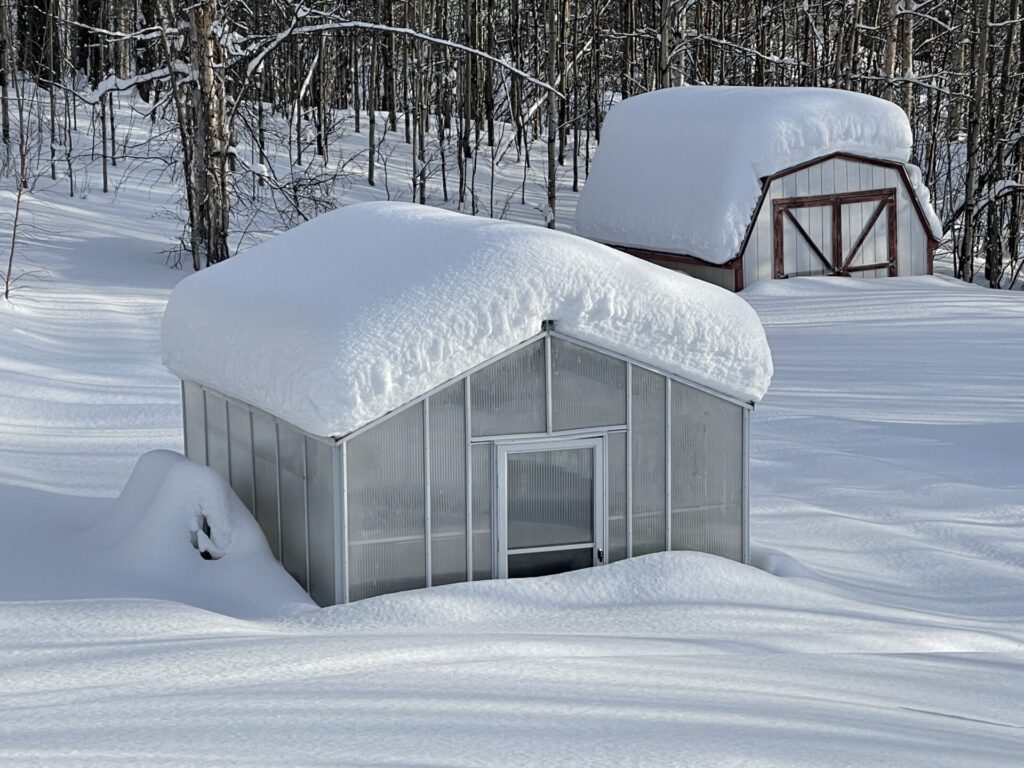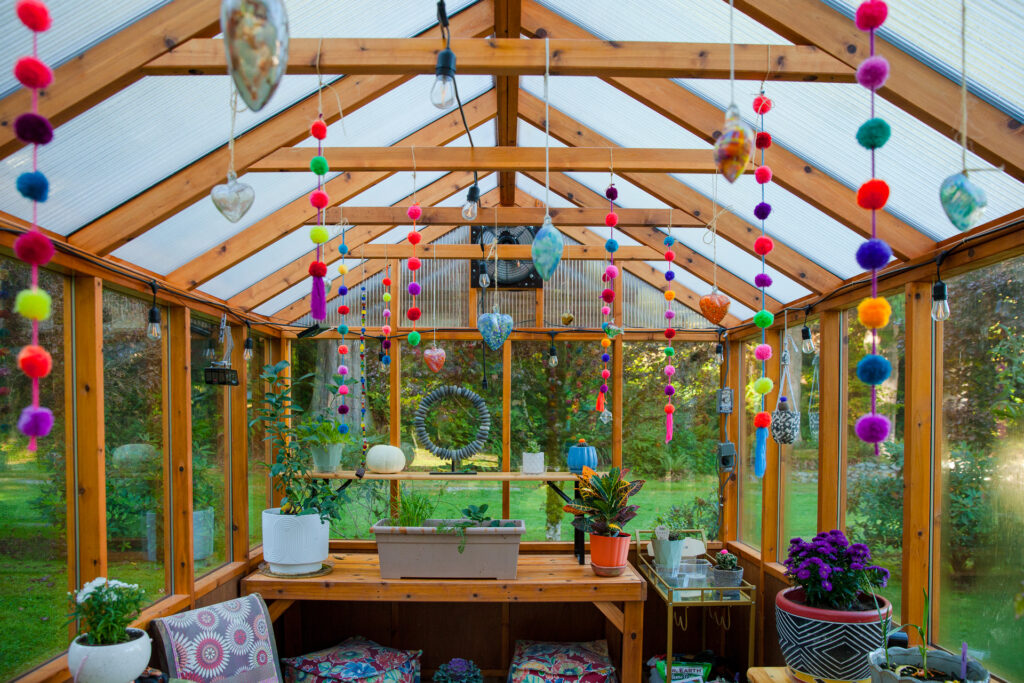Part 2 of our Glass vs. Polycarbonate Greenhouse Guide
What’s the Difference Between Glass and Polycarbonate Greenhouses?
If you’ve already read Part 1 of our Glass vs. Polycarbonate comparison, you know both glazing materials have unique strengths. In this second part, we’ll go beyond general pros and cons to help you decide which glazing will perform best for your specific climate, growing goals, and style preferences.
Whether you garden through Pacific Northwest drizzle or Southwest desert sunshine, the right glazing can make all the difference in how your greenhouse feels, functions, and performs.
Which Glazing Is Best for Cold, Hot, or Sunny Climates?
Your local climate is the first thing to consider when choosing between glass and polycarbonate. Each performs differently under temperature swings and sunlight intensity.
| Climate Type | Best Glazing Choice | Why It Works |
| Cool or Cloudy (Pacific Northwest, Northern U.S.) | Double Glass or Twinwall Polycarbonate | Insulated panels trap heat and diffuse light on gray days. |
| Hot or Sunny (Southwest, Inland West) | Tempered Safety Glass or Twinwall Polycarbonate | Great fit for the hybrid option of glass sidewalls and Twinwall roof. The glass keeps your greenhouse bright and airy, while the Twinwall roof reduces glare and helps control heat buildup. |
| Mixed Seasons (Midwest, Northeast) | Double Glass, Triple-Wall or Fivewall Polycarbonate | Balances clarity, insulation, and year-round durability. |
If you live in a region with long, cool winters and limited sun, polycarbonate panels are your best ally for insulation and diffused light. For gardeners in hot or sunny areas, a combination of single glass sidewalls with a Twinwall polycarbonate roof is a smart, efficient setup that keeps your space bright while preventing overheating and scorching.
How Light Levels Affect What You Grow
The kind of light inside your greenhouse influences which crops will thrive. Glass delivers the most clarity, allowing up to 95 percent of natural sunlight to reach your plants. This makes it a favorite for citrus, succulents, and Mediterranean herbs that crave direct light. Polycarbonate, on the other hand, diffuses sunlight more evenly. This prevents leaf scorch and creates a softer, balanced glow that keeps greens, seedlings, and ornamentals happy.
Many gardeners find that a blend of both works best. Using clear glass on the sun-facing side provides brightness, while polycarbonate on the roof or shaded walls keeps temperatures even and reduces heat loss. It is all about balance and what fits your growing style.
Glazing Durability and Maintenance
Both glazing types are long-lasting, but they age in different ways. All of Charley’s glass panels are tempered safety glass, which means they’re much stronger than standard glass and, if broken, crumble into small, blunt pieces rather than sharp shards. Tempered glass can still break under the right conditions—such as a hard impact or extreme stress—but it’s a very durable choice for most climates and offers decades of clear, dependable performance.
Our polycarbonate panels are built to last, too. Each one includes a UV-protective layer that helps prevent yellowing or brittleness caused by constant sun exposure. Over time, every polycarbonate panel will gradually age from UV light, but the lifespan is measured in decades, not years. How soon you might need to replace panels depends on how intense the sun is in your region, but most gardeners enjoy many seasons of reliable use before that ever becomes a concern.
Whichever glazing you choose, a little care goes a long way. A gentle wash once or twice a year using mild soap and a soft cloth is usually all that’s needed. Regular cleaning keeps light levels high and your greenhouse looking its best.

Greenhouse Energy Efficiency and Insulation
If you are hoping to garden through chilly winters, energy efficiency should be a top priority. Polycarbonate glazing typically offers higher insulation, measured by what is called the R-value. The higher the R-value, the better the material resists heat loss.
Depending on the panel thickness, polycarbonate can reduce heat loss by 40 to 65 percent compared to single-pane glass. That extra insulation makes a big difference on cool nights and in winter weather, keeping your greenhouse more comfortable and reducing how often you need supplemental heat.
Glass still provides beautiful clarity and long-term durability, and upgrading to double-pane glass narrows the insulation gap considerably. But for most gardeners, polycarbonate remains the best balance of efficiency, weight, and cost.
Greenhouse Glazing Comparison: R-Values and Light Transmission
When comparing greenhouse materials, two numbers tell most of the story:
- R-Value: How well the material resists heat loss (higher means better insulation).
- Light Transmission: How much sunlight passes through (higher means a brighter interior).
| Glazing Type | R-Value (Insulation) | Light Transmission | Available In |
| 3mm Single Glass | 0.96 | ≈ 95% | Cross Country Models |
| Double-Pane Safety Glass (5/8″) | 2.03 | ≈ 90% | Cross Country Models, Heritage: Alpine Model |
| 6mm Twinwall Polycarbonate | 1.62 | ≈ 82% | Cross Country Models, Winter Gardenz |
| 10mm Twinwall Polycarbonate (3/8″) | 1.9 | ≈ 82% | Heritage: Woodland Model |
| 16mm Triple-Wall Polycarbonate (5/8″) (Walls) | 2.5 | ≈ 74% | Heritage: Alpine Model |
| 16mm Fivewall Polycarbonate (5/8″) | 3.0 | ≈ 62% | Cross Country Models |
| 16mm Super 5X-Wall Polycarbonate (5/8″) (Roof) | 2.78 | ≈ 64% | Heritage: Alpine Model |
If your top priority is insulation, the Fivewall or Super 5X-Wall polycarbonate offers the highest R-value. For gardeners who want a crystal-clear view of their plants, single or double-pane glass remains unmatched for brightness. Triple-wall polycarbonate and double-pane glass both provide an excellent middle ground with good clarity and comfort.
Glazing Appearance and Longevity
There is no denying that glass has a classic beauty. It reflects sunlight like a jewel and blends seamlessly with homes, patios, and gardens. The view through glass is completely clear, which makes it the best choice if you want to see into your greenhouse or enjoy an unobstructed view from inside looking out.
Polycarbonate, on the other hand, has a softly diffused, translucent look. You can see light and color through it, but not sharp detail. For some gardeners, that gentle blur is a welcome feature rather than a drawback. It provides a sense of privacy and keeps the focus on the overall garden rather than what is inside the greenhouse. The diffused light also helps prevent glare, creating a calm, even glow that plants and people both enjoy.
Both materials can last for decades with regular care. Glass maintains its clarity year after year, while high-quality polycarbonate panels have a UV-protective coating that helps them resist yellowing or brittleness from the sun. Whether you prefer the crystal-clear charm of glass or the modern, softly filtered light of polycarbonate, both offer long-term performance that makes your greenhouse a lasting addition to your space.
The Best of Both Worlds: Combining Glass and Polycarbonate
If you love the elegant look of glass but want to save energy, consider combining materials. A popular setup is glass sidewalls with a polycarbonate roof. This hybrid design gives you clear visibility and a classic aesthetic at eye level, while the insulated roof keeps heat inside where it belongs.
Many gardeners choose this option because it offers comfort, performance, and affordability all in one package. You will find this hybrid approach available in several of our Cross Country and Heritage Wood Greenhouses. It is one of the smartest ways to create a greenhouse that looks beautiful year-round and performs efficiently in any season.
How to Choose the Right Greenhouse Glazing
When deciding between glass and polycarbonate, think about your goals first.
- If you love the look of traditional architecture and want the brightest interior possible, glass will always be timeless.
- If you want lower heating costs, lighter weight, and better insulation, polycarbonate is your best bet.
- If you want both beauty and practicality, a combination of the two materials creates an ideal balance.
No matter which you choose, the most important thing is that your greenhouse suits your growing style and climate. A well-chosen glazing material will reward you with better harvests, lower maintenance, and a space you love spending time in.
Take the Next Step
Still deciding which greenhouse glazing or model is right for you?
Start with our Greenhouse Buyer’s Checklist. It is a quick, helpful tool that walks you through key decisions like size, style, and glazing.
Not sure which direction to go after that? Our friendly team of experts are happy to help you match the right glazing to your location, plants, and budget. With the right guidance, you can choose a greenhouse that fits both your climate and your vision for years to come.






